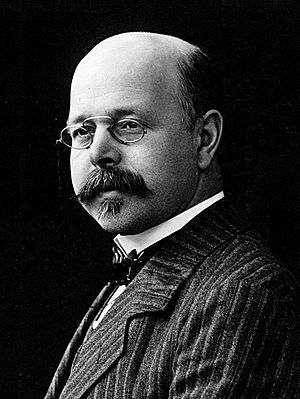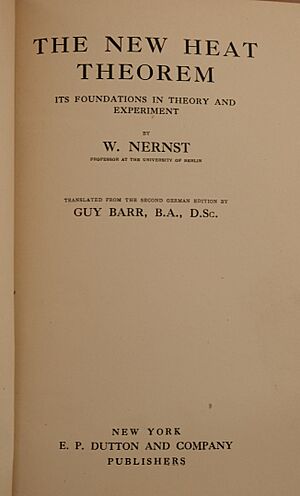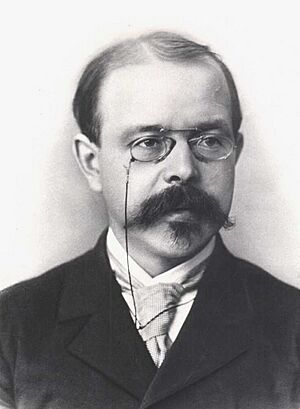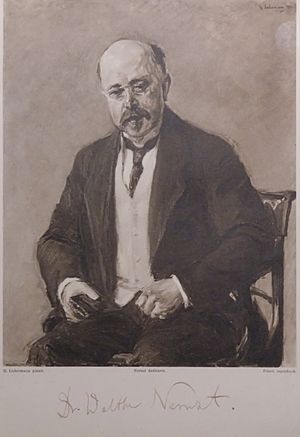Walther Nernst facts for kids
Quick facts for kids
Walther Nernst
|
|
|---|---|
 |
|
| Born | 25 June 1864 |
| Died | 18 November 1941 (aged 77) |
| Nationality | German |
| Alma mater | University of Zürich Friedrich Wilhelm University University of Graz Julius Maximilian University of Würzburg |
| Known for | Third Law of Thermodynamics Nernst lamp Nernst equation Nernst effect Nernst heat theorem Nernst potential Nernst–Planck equation Nernst's distribution law |
| Awards | Pour le Mérite (1917) Nobel Prize in chemistry (1920) Franklin Medal (1928) ForMemRS (1932) |
| Scientific career | |
| Fields | Chemistry |
| Institutions | Georg August University of Göttingen Friedrich Wilhelm University Leipzig University |
| Doctoral advisor | Friedrich Kohlrausch |
| Other academic advisors | Ludwig Boltzmann |
| Doctoral students | Sir Francis Simon Richard Abegg Irving Langmuir Leonid Andrussow Karl Friedrich Bonhoeffer Frederick Lindemann William Duane Margaret Eliza Maltby Arnold Eucken |
| Other notable students | Gilbert N. Lewis Max Bodenstein Robert von Lieben Kurt Mendelssohn Theodor Wulf Emil Bose Hermann Irving Schlesinger Claude Hudson |
| Influenced | J. R. Partington |
| Signature | |
 |
|
Walther Hermann Nernst (born June 25, 1864 – died November 18, 1941) was a German chemist. He was famous for his work in thermodynamics (the study of heat and energy), physical chemistry (how physics and chemistry mix), electrochemistry (how electricity and chemical reactions work), and solid state physics (the study of solid materials).
Nernst created the Nernst heat theorem. This idea helped lead to the third law of thermodynamics, which explains what happens to matter at very cold temperatures. For this important work, he won the 1920 Nobel Prize in Chemistry. He also developed the Nernst equation in 1887, which is used to understand how electricity moves in solutions.
Contents
Life and Discoveries
Early Life and Education
Walther Nernst was born in Briesen, Prussia (which is now Wąbrzeźno, Poland). His father, Gustav Nernst, was a judge. Walther had three older sisters and one younger brother. Sadly, one of his sisters died from cholera.
Walther went to elementary school in Graudenz. He loved to study physics and mathematics. He attended several universities, including Zürich, Berlin, Graz, and Würzburg. He earned his doctorate degree in 1887. In 1889, he completed his habilitation at the University of Leipzig, which allowed him to teach at a university.
A Scientist's Personality
People said that Nernst was very practical. He always thought about how new scientific discoveries could be used in real life, especially in factories and businesses. He enjoyed hunting and fishing in his free time.
His friend, the famous scientist Albert Einstein, found Nernst's "childlike vanity" amusing. Einstein also noted that Nernst's study and lab were always very messy! His co-workers even called it "the state of maximum entropy," which is a science joke about disorder.
Family Life
In 1892, Nernst married Emma Lohmeyer. They had two sons and three daughters. Sadly, both of their sons died while fighting in World War I.
Nernst was a strong critic of Adolf Hitler and the Nazi party. Two of his daughters married Jewish men. When Hitler came to power, these daughters and their husbands had to leave Germany. One moved to England and the other to Brazil.
Nernst's Career and Inventions
Nernst started his university studies in Zurich in 1883. He later moved to Graz, where he worked with Albert von Ettingshausen. Together, they discovered the Nernst effect. This effect shows that if you put a metal wire in a magnetic field and heat one end, an electric voltage appears across the wire.
After Graz, he moved to Würzburg and then to Leipzig. There, he worked on how electricity behaves in solutions. He then taught briefly at Heidelberg before moving to Göttingen.
At Göttingen, Nernst wrote a very popular textbook called Theoretical Chemistry. This book was so important that it was translated into English, French, and Russian. He also developed the Nernst equation. This equation helps scientists understand the electrical signal created when different amounts of a substance are separated by a membrane, like in our nerve cells. It is still used today in the study of cells and the brain.
The light bulbs used back then had a carbon filament and were dim and expensive. Nernst invented a new type of light source called the Nernst glower. It used special rare-earth materials that glowed brightly when heated. This lamp is still used today in infrared spectroscopy, a way to study materials using light. Nernst sold his patent for the lamp for a lot of money. With his new wealth, he bought many cars and a large country estate for hunting. He even found a way to make his early cars more powerful by adding nitrous oxide!
After 18 years at Göttingen, Nernst moved to Berlin. He was given the special title Geheimrat.
In 1905, Nernst proposed his "New Heat Theorem," which later became known as the Third law of thermodynamics. This law states that as the temperature of a substance gets closer to absolute zero (the coldest possible temperature), its entropy (a measure of disorder) also gets closer to zero. This discovery was very important because it allowed chemists to figure out how chemical reactions would behave just by measuring heat.
Nernst became friends with Kaiser Wilhelm, the German emperor. He convinced the Kaiser to create the Kaiser Wilhelm Society, an organization to support scientific research. Nernst's lab also found that the specific heats (how much energy it takes to heat something up) of materials dropped a lot at low temperatures. This was later explained by Albert Einstein using quantum mechanics. Nernst was so impressed by Einstein that he traveled to Zurich to meet him. People in Zurich were surprised, saying, "Einstein must be a clever fellow if the great Nernst comes all the way from Berlin to Zurich to talk to him."
In 1911, Nernst and Max Planck organized the first Solvay Conference, a meeting of top scientists in Brussels. The next year, a famous painter named Max Liebermann painted Nernst's portrait.
When World War I started in 1914, Nernst's two older sons joined the army. Nernst himself volunteered to drive documents for the German army. He even drove so close to the front lines that he could see the lights of Paris at night! When the war became a stalemate (no side could win), Nernst suggested using tear gas to drive enemies out of their trenches. Another scientist, Fritz Haber, suggested using heavier, poisonous gas instead. Nernst was awarded the Iron Cross for his service. He also directed research on explosives and helped develop new weapons. Sadly, both of his sons died in the war.
In 1918, Nernst developed the idea of an atomic chain reaction. He suggested that if a reaction creates free atoms that can break apart other molecules, it could lead to a chain reaction. This idea is similar to how nuclear fission works.
In 1920, Nernst received the Nobel Prize in Chemistry for his work on heat and chemical reactions. He was also chosen to be the head of Berlin University for a year. He helped set up a system to get money for young scientists.
Nernst was also interested in music. In 1930, he helped create an electric grand piano called the "Neo-Bechstein-Flügel." This piano used electronics to make and amplify its sound, much like an electric guitar. Nernst himself was a pianist and sometimes played with Einstein, who played the violin.
In 1933, Nernst saw how the Nazi government was treating Jewish people. He was upset when a Jewish colleague was fired. Nernst himself got into trouble for refusing to fill out a form about his family's background. He retired from his professorship and moved to the countryside. In 1937, he visited Oxford, England, to receive an honorary degree and see his daughter and grandchildren.
Walther Nernst had a severe heart attack in 1939 and passed away in 1941. He was buried three times, finally resting near other famous scientists like Max Planck in Göttingen, Germany.
Honors and Legacy
In 1923, a botanist named Ignatz Urban named a new genus (a group of plants) of flowering plants from Mexico Nernstia in his honor.
See also
 In Spanish: Walther Nernst para niños
In Spanish: Walther Nernst para niños
- German inventors and discoverers
- C. Bechstein Pianofortefabrik
- Chain reaction
- Cosmological constant problem
- Cosmic background radiation
- History of electrophoresis
- Nernst–Einstein equation
- Nernst–Lewis–Latimer convention
- Solid state ionics
- Stochastic electrodynamics
- Threshold potential
- Tired light
- Zero-point energy




